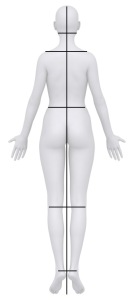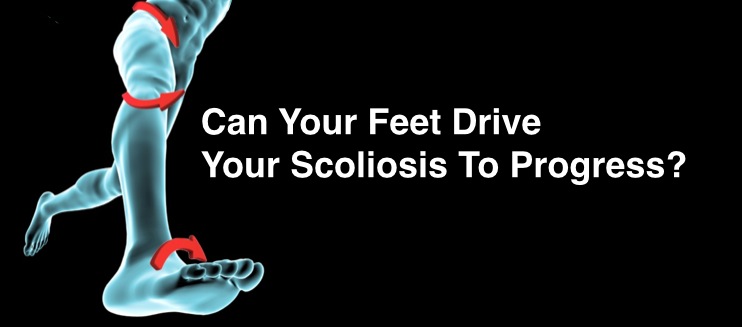While scoliosis is a condition that affects the spine there are many other conditions that can be a contributing factor that drives the curvature. One of the most common are imbalances in the pelvis and lower extremities.
 In optimum upright human posture the head should be positioned evenly over the midline of the shoulder, rib cage, lumbar spine, pelvis, knees ankles and feet. Anything that causes a deviation from orthogonal position can greatly impact the posture of the body and exacerbate a scoliosis imbalance.
In optimum upright human posture the head should be positioned evenly over the midline of the shoulder, rib cage, lumbar spine, pelvis, knees ankles and feet. Anything that causes a deviation from orthogonal position can greatly impact the posture of the body and exacerbate a scoliosis imbalance.
Just as an imbalance in the base of a building can cause challenges the structure overhead, think of the leaning tower of Pisa which is only 4 degrees off it’s vertical balance, imbalances in the pelvis and lower extremities can cause problems to the structural integrity of the spine above it. When the base is not level the spine must adapt in order to keep the eyes level with the horizon.
Imbalances That Can Drive Your Scoliosis To Progress
The following are some of the more common contributing factors that if they are a problem need to be addressed to allow for optimal conservative management of a scoliosis.
Leg Length Discrepencies
There are two types of leg length discrepencies that are commonly referred to by doctors.
- Apparent Leg Length Deficiency – The legs are of equal length but one side of the body is drawing the leg up on that side due to imbalances in the postural muscles of the pelvis and trunk
- True Leg Length Deficency – There is an actual difference in length from left to right
If there is a true leg length deficiency then consideration must be made for providing a shoe lift to the side of deficiency but only if an addition of a lift will also appear to help improve the scoliosis. If adding a lift to the deficient side would worsen the scoliosis then it would be contra-indicated.
An apparent short leg can result from an imbalance in the pelvis or can be a compensatory mechanism involving the balance systems of the spine. Treatment can include chiropractic adjustments to restore motion to the pelvis, active release treatment to the adaptively shortened muscles of the spiral lines of the body in the pelvis and trunk or atlas orthogonal treatment to help reduce neurologic mal-adaptations in the postural mechanisms of the spine.
Pes Valgus or Varus
Pes Valgus is a condition that is commonly known as a “flat foot”. It can occur on one side or bilaterally and it can affect the postural integrity of the lower extremity and foot. When the postural muscles of the arch of the foot are weakened then foot flattens inward. This causes a torque to the knee, hip, pelvis and eventually the spine.
This torque force can help drive the progression of the scoliosis by adding to the abnormal rotational forces on the spine and must be addressed in order to help improve the curvature.
Corrective exercise to help restore the arch of the foot, such as a “Short Foot” exercise, walking barefoot over uneven terrain or even barefoot running can sometimes be very beneficial in helping restore the proper biomechanical function of the arch of the foot.
The use of custom orthotics are another excellent way to help improve the biomechanical position of the foot to help de-torque the lower extremities and reduce the imbalances that are contributing to the scoliosis, but only if the orthotic is cast in the corrected position.


And I thought it was the scoliosis that caused my twisted pelvis and different leg lengths. Chicken and egg here.
EMMA I HAVE THE SAME SYMPTONS AS YOU. TWISTED PELVIS AND ONE LEG IS SHORTER THAN THE OTHER. WHAT WAS YOUR OUTCOME.
I have also been diagnosed as having Benign Hyper Mobility Joint Syndrome (aka double-jointed, or more commonly and correctly diagnosed as “Loose Joints” by a Hand Surgeon when the General Orthopedic Surgeon says the patient has/had Carpal Tunnel Syndrome).
Some people think that having “Loose Joints” is wonderful because as a little girl,she would be able to perform well in ice skating, gymnastics, or other activities that requires extreme joint flexibility. As a 54 year young woman, my shoulders easily dislocate, I have always had flat feet, and so on.
I’m suspecting that I have this problem too. I have been told that I have hypermobility by a physical therapist. I was extremely flexible as a child. I’ve read that one way it can manifest is in the bones of the feet, causing this “flat foot” phenomenon (even though the arch exists when the foot isn’t standing.) I’m beginning to wonder if that’s what’s been at the root of my scoliosis…. fascinating stuff Dr. Diaz!
Michaela, Thank you. It very well could be the root of your scoliosis or at least a contributing factor. Let us know if we can help.
I have flat feet & wear Orthotics..
I have also been told that I have scoliosis, forcing my spine to make an s-curve, vertically.
Constance,
Yes, flat feet can impact your scoliosis in the way you described and can be one of the driving forces that cause the curves to worsen as the dropping of the foot caused a torque to the knee, hip and pelvis. Getting support for the foot can help mitigate these forces.
I am positive that knee replacement in only one knee will extend that leg to be longer than the leg that the knee was not replaced.
My son has recently been diagnosed with scoliosis (73T/56L). I have wondered for awhile if he has one leg shorter than the other/flat feet. What type of doctor do I need to meet with to determine this (podiatrist, orthopedic, etc?) Could they determine if it is making his scoliosis worse? Thanks for your help!
Stacey,
Have you ever heard the fable of the 5 blind wise men each describing an elephant based on the part of the elephant they touched. (ie: tail, trunk, leg, etc.) Each gave a completely different description based on what THEY FELT.
The same would be true with leg length, and flat feet affecting scoliosis. So the best person to evaluate that would be a chiropractor who specializes in scoliosis.
most of people i see with scoliosis, also has pes planus, usually too, its bilateral. is it aslo because of neuromuscular imbalance, as noter by clayyon stitzel in his studies of scoliodis?
Federico,
I agree that many people who have scoliosis, especially lumbar curves also have some type of neuromuscular imbalances that are aggravating their scoliosis. In these cases the imbalances also need to be addressed. Here is another article I’ve written related to that subject. http://scoliosistreatmentalternatives.com/3946/changing-your-brain-to-improve-your-scoliosis-part-ii/